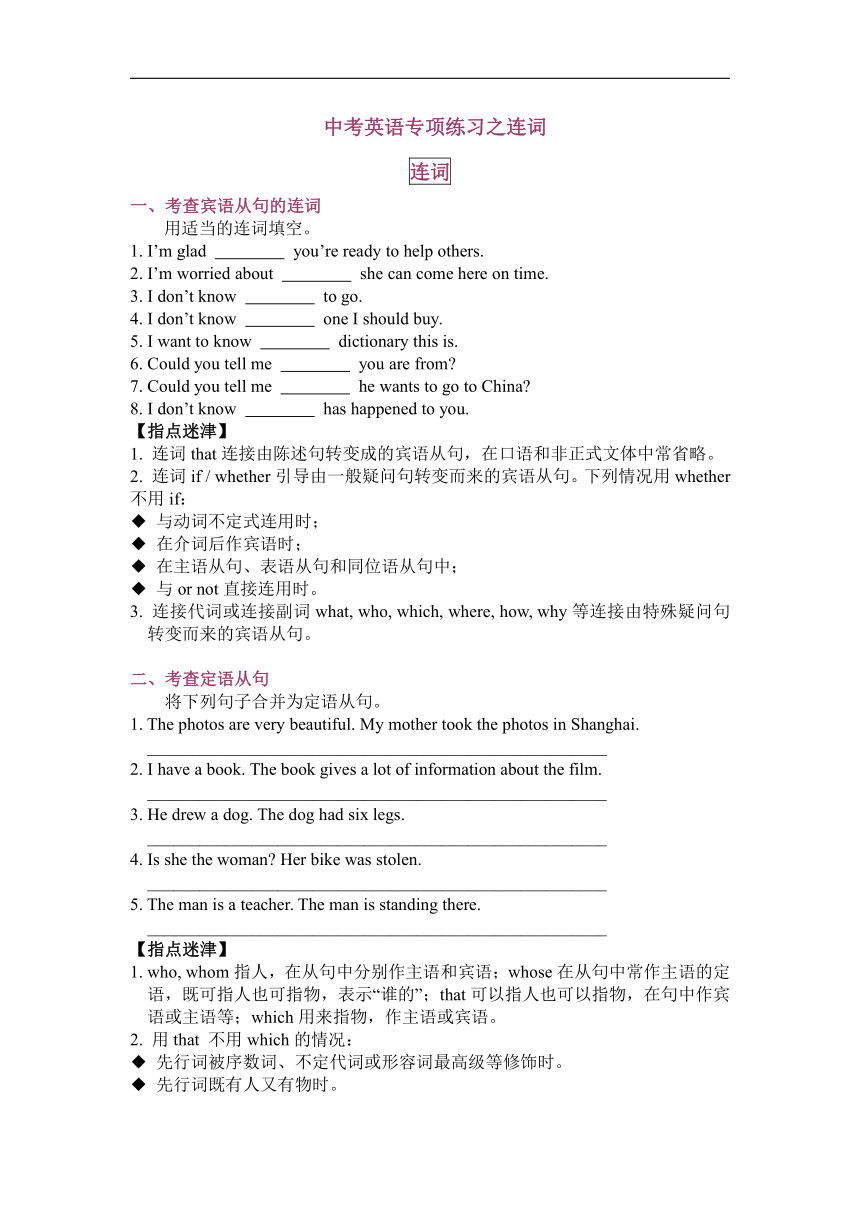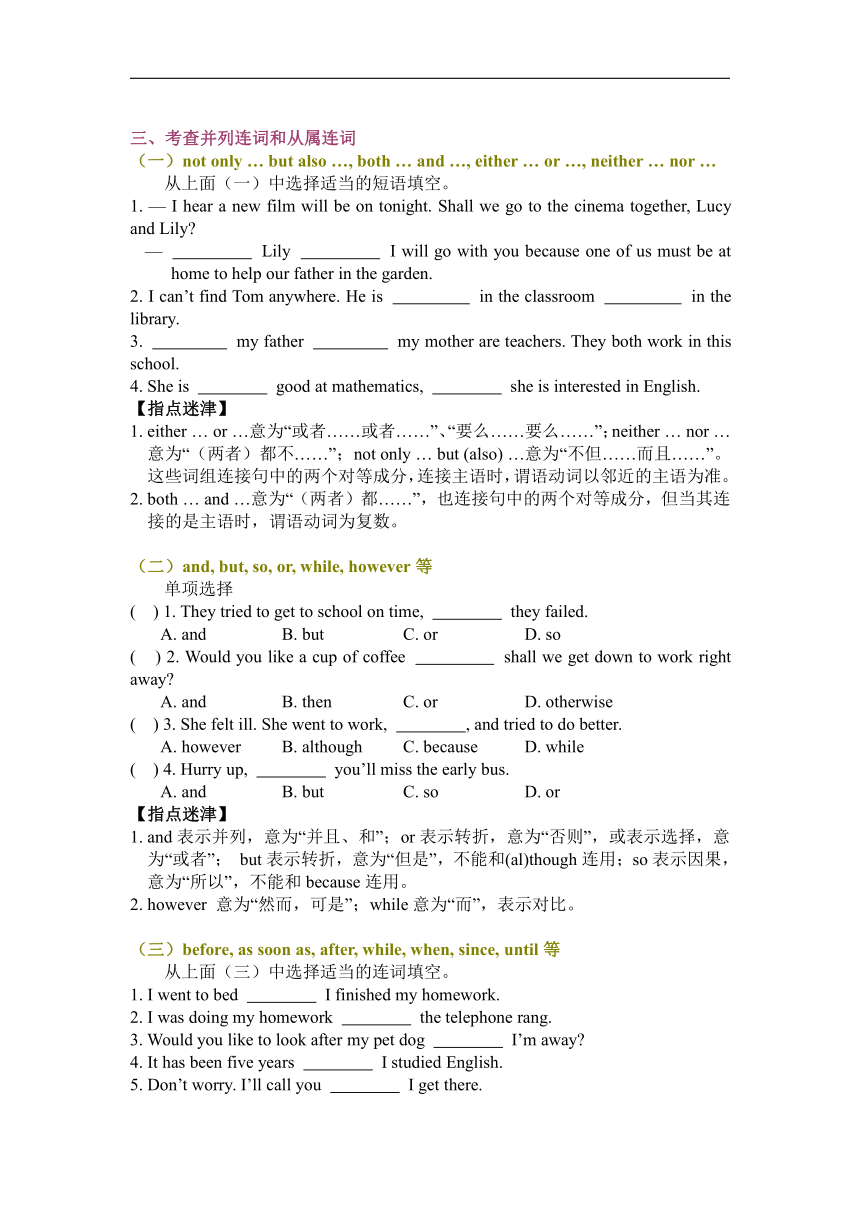中考英语语法专项: 连词(含答案)
图片预览


文档简介
中考英语专项练习之连词
连词
一、考查宾语从句的连词
用适当的连词填空。
1. I’m glad you’re ready to help others.
2. I’m worried about she can come here on time.
3. I don’t know to go.
4. I don’t know one I should buy.
5. I want to know dictionary this is.
6. Could you tell me you are from?
7. Could you tell me he wants to go to China?
8. I don’t know has happened to you.
【指点迷津】
1. 连词that连接由陈述句转变成的宾语从句,在口语和非正式文体中常省略。
2. 连词if / whether引导由一般疑问句转变而来的宾语从句。下列情况用whether不用if:
◆ 与动词不定式连用时;
◆ 在介词后作宾语时;
◆ 在主语从句、表语从句和同位语从句中;
◆ 与or not直接连用时。
3. 连接代词或连接副词what, who, which, where, how, why等连接由特殊疑问句转变而来的宾语从句。
二、考查定语从句
将下列句子合并为定语从句。
1. The photos are very beautiful. My mother took the photos in Shanghai.
_____________________________________________________
2. I have a book. The book gives a lot of information about the film.
_____________________________________________________
3. He drew a dog. The dog had six legs.
_____________________________________________________
4. Is she the woman? Her bike was stolen.
_____________________________________________________
5. The man is a teacher. The man is standing there.
_____________________________________________________
【指点迷津】
1. who, whom指人,在从句中分别作主语和宾语;whose在从句中常作主语的定语,既可指人也可指物,表示“谁的”;that可以指人也可以指物,在句中作宾语或主语等;which用来指物,作主语或宾语。
2. 用that 不用which的情况:
◆ 先行词被序数词、不定代词或形容词最高级等修饰时。
◆ 先行词既有人又有物时。
三、考查并列连词和从属连词
(一)not only … but also …, both … and …, either … or …, neither … nor …
从上面(一)中选择适当的短语填空。
1. — I hear a new film will be on tonight. Shall we go to the cinema together, Lucy and Lily?
— Lily I will go with you because one of us must be at home to help our father in the garden.
2. I can’t find Tom anywhere. He is in the classroom in the library.
3. my father my mother are teachers. They both work in this school.
4. She is good at mathematics, she is interested in English.
【指点迷津】
1. either … or …意为“或者……或者……”、“要么……要么……”;neither … nor …意为“(两者)都不……”;not only … but (also) …意为“不但……而且……”。这些词组连接句中的两个对等成分,连接主语时,谓语动词以邻近的主语为准。
2. both … and …意为“(两者)都……”,也连接句中的两个对等成分,但当其连接的是主语时,谓语动词为复数。
(二)and, but, so, or, while, however等
单项选择
( ) 1. They tried to get to school on time, they failed.
A. and B. but C. or D. so
( ) 2. Would you like a cup of coffee shall we get down to work right away?
A. and B. then C. or D. otherwise
( ) 3. She felt ill. She went to work, , and tried to do better.
A. however B. although C. because D. while
( ) 4. Hurry up, you’ll miss the early bus.
A. and B. but C. so D. or
【指点迷津】
1. and表示并列,意为“并且、和”;or表示转折,意为“否则”,或表示选择,意为“或者”; but表示转折,意为“但是”,不能和(al)though连用;so表示因果,意为“所以”,不能和because连用。
2. however 意为“然而,可是”;while意为“而”,表示对比。
(三)before, as soon as, after, while, when, since, until等
从上面(三)中选择适当的连词填空。
1. I went to bed I finished my homework.
2. I was doing my homework the telephone rang.
3. Would you like to look after my pet dog I’m away?
4. It has been five years I studied English.
5. Don’t worry. I’ll call you I get there.
6. My parents didn’t go to bed I came back.
【指点迷津】
1. after意为“在……之后”,通常用于过去时、现在时或完成时的句子中;before意为“在……之前”,常用于过去时和一般现在时。
2. when引导的从句可用瞬间动词,也可用延续性动词。while表示从句与主句的动作同时发生,用延续性动词。as引导的时间状语从句中的动作与主句中的动作同时发生,强调“一边……一边……”。since意为“自从……”,引导的从句一般用过去时,主句用完成时。
3. as soon as意为“一……就……”,该连词所在的主从复合句中,主句用一般将来时,从句用一般现在时表将来。
(四)so … that …, such … that …, so that等
将下列汉语句子翻译成英语。
1. 这个男孩年龄如此大能够去上学了。
2. 她在网上买了一个MP4,因此节省了很多时间。
3. 他告诉了我们一个如此滑稽的故事,以至于我们都笑了。
【指点迷津】
1. so … that引导结果状语从句,意为“如此……以至于……”,常用句型为so + adj./adv. + that从句。
2. so that引导目的状语从句时,其从句的谓语动词多和情态动词can, could, may, might, would等连用。so that也能引导结果状语从句,但从句中一般不用情态动词。
3. such … that意为“如此……以至于……”,such后常跟名词或名词短语,常用句型为:such + a / an +adj. + n.+that从句或such + adj. + 不可数名词或复数名词+that从句。
(五)because, for, since, as
选词填空
1. It must have rained during the night, the road is wet.
2. it is Sunday today, you may go to the park.
3. We stayed at home it rained.
【指点迷津】
1. because是从属连词,语气最强,可位于句首;也可位于主句之后,常用来回答why引导的特殊疑问句。
2. for意为“因为”,并列连词,语气较弱,一般放在主要分句之后,用逗号隔开。
3. since是从属连词,意为“既然”,常放在句首,用于表示一种已知的、显然的理由。
4. as意为“因为;既然”,从属连词,语气较弱,一般用于句首,常用于指对话双方都明白的原因。
Key:
一、1. that 2. whether 3. where 4. which 5. whose
6. where 7. if / whether / why 8. what
二、1. The photos that my mother took in Shanghai are very beautiful.
2. I have a book that gives a lot of information about the film.
3. He drew a dog which had six legs.
4. Is she the woman whose bike was stolen?
5. The man who is standing there is a teacher.
三、(一)1. Either; or 2. neither; nor 3. Both; and 4. not only; but also
(二) 1-4 BCAD
(三)1. after 2. when 3. while 4. since
5. as soon as / when 6. until
(四)1. The man is so old that he cannot walk fast.
2. She bought an MP4 player online so that she saved a lot of time.
3. He told us such a funny story that we all laughed.
(五)1. for 2. Since / As 3. because
同课章节目录
- 词法
- 名词
- 动词和动词短语
- 动词语态
- 动词时态
- 助动词和情态动词
- 非谓语动词
- 冠词
- 代词
- 数词和量词
- 形容词副词及其比较等级
- 介词和介词短语
- 连词和感叹词
- 构词法
- 相似、相近词比较
- 句法
- 陈述句
- 一般疑问句和否定疑问句
- 特殊疑问句及选择疑问句
- 反意疑问句
- 存在句(There be句型)
- 宾语从句
- 定语从句
- 状语从句
- 主谓一致问题
- 简单句
- 并列句
- 复合句
- 主谓一致
- 主、表语从句
- 名词性从句
- 直接引语和间接引语
- 虚拟语气
- 感叹句
- 强调句
- 倒装句
- 祈使句
- 句子的成分
- 句子的分类
- 题型专区
- 单项选择部分
- 易错题
- 完形填空
- 阅读理解
- 词汇练习
- 听说训练
- 句型转换
- 补全对话
- 短文改错
- 翻译
- 书面表达
- 任务型阅读
- 语法填空
- 其他资料
